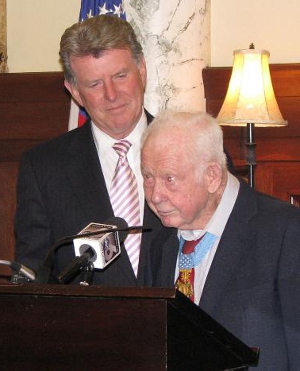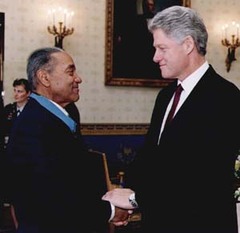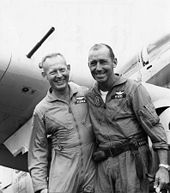North Idaho Highway 3 renamed
 |
| Idaho Governor Butch Otter looks on as Medal of Honor recipient Bernie Fisher addresses those gathered for the signing of Senate Bill 1050 |
"With the recent passing of Vernon Baker from St. Maries," the Senate wrote, "it is an appropriate time to recognize the exceptional valor displayed by recipients of our nation's highest honor."
Medal of Honor recipient retired Air Force Lieutenant Colonel Bernie Fisher, Kuna, Idaho, attended the signing.
Idaho is home to many whose bravery and valor in combat resulted in the bestowing of the Medal of Honor. In World War I, Thomas C. Neibaur became both the first Latter-day Saint and the first Idahoan to receive the Medal of Honor. He enlisted in the Idaho National Guard March 30, 1917, one week before the U.S. declared war on Germany.
On October 16, 1918, American Forces captured Cote de Chatillon, France, though several pockets of German units remained, along with several isolated enemy machine gun positions. Neibaur and two other soldiers volunteered to flank and remove a network of machine gun nests. Crawling up between two spurs, the rifle team encountered a wire obstacle and began taking fire. His two companions were killed and Neibaur was wounded three times in his right thigh. He managed to cross the obstacle and position his automatic rifle behind a dirt berm, but he was spotted and attacked by about 50 German soldiers. He opened fire, killing or wounding most of them until his rifle jammed.
Discarding his rifle, he tried to run and crawl the hundred yards to friendly lines when he was wounded a fourth time in the hip, and he fell unconscious. Awakening, he found himself captured by 15 or so survivors of the German element that had attacked him. Due to covering fire from Neibaur's M Company, the Germans had to take cover, and Neibaur noticed that one of them dropped his pistol. As he crawled to it, he was again charged by Germans wielding bayonets, but he managed to grab the pistol, kill four and capture 11, who he then led to American lines despite his wounds.
Private Neibuar spent months in field hosptials recovering from his wounds, and carried the last bullet to hit him for the rest of his life. He died December 23, 1942.
During World War II, Army Private First Class Leonard C. Brostrom, Preston, Army Private First Class William K. Nakamura, Hunt, a Japanese-American who had earlier been confined to an intern camp in Minidoka before enlisting to serve his country and who died July 4, 1944, providing covering fire to allow his unit's safe withdrawal from heavy machine gun fire in Castellina, Italy, and Army Private Nathan K. Van Noy Jr., also of Preston, were each awarded the Medal of Honor posthumously. Army Technician First Class Robert Dale Maxwell, Boise, Marine Colonel Gregory "Pappy" Boyington, Coeur d'Alene, and Army Private Lloyd G. McCarter, St. Maries, each survived to recieve the Medal of Honor.
 |
| Vernon Baker receiving his belated Medal of Honor from President Bill Clinton in 1997. |
During the Korean War, Idahoans Army Sergeant David Bruce Bleak, Shelley, Marine Private First Class Herbert A. Littleton, Nampa, Marine Colonel Reginald R. Myers, Boise, and Army Corporal Dan D. Schoonover, Boise, who died at the second battle of Pork Chop Hill, and Marine Sergeant James Edmond Johnson, Pocatello, received Medals of Honor.
 |
| Air Force Colonel Bernard Francis Fisher |
He was able to escape the downed aircraft and take cover, and Fisher, realizing that the closest helicopter was over half an hour away while enemy soldiers were closing in on Myer's position from only 200 yards away, landed his two seater near his friend while two other A-1s provided cover.
Fisher taxied to Myer's position, loaded the downed airman in the empty back seat and was able to dodge shell holes and debris in the runway to safely take off, despite being hit multiple times by small arms fire.
 |
| Fisher and "Jump" Myers shortly after the rescue. |
He was presented the Medal of Honor by President Lyndon Johnson on January 19, 1967.
Under the new designation, the Idaho Transportation Department will be erecting special signs along the North Idaho Medal of Honor Highway to honor these Idahoans for their service to our nation in its armed forces.